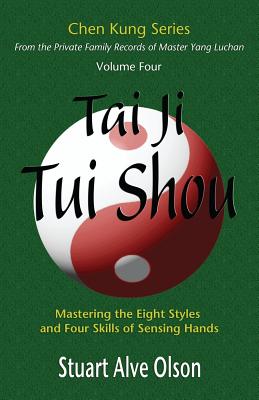Tai Ji Tui Shou: Mastering the Eight Styles and Four Skills of Sensing Hands

Tai Ji Tui Shou: Mastering the Eight Styles and Four Skills of Sensing Hands
Every gesture in Sensing Hands (as well as in Greater Rolling-Back and Dispersing Hands) is designed to be practiced with the idea that you are being neutralized before actually expressing the energy to knock over an opponent. The exercises in themselves are a stalemate of joined movements. To practice otherwise, with the idea of winning and actually Issuing, destroys the very cause for learning how to Interpret. Issuing will come later. It will develop without your expressing it in the exercises.
While the companion book Tai Ji Jin (vol. 2) explains the various Intrinsic Energies (Jin) of Taijiquan, Tai Ji Tui Shou and Tai Ji San Shou and Da Lu (vol. 5) teach you how to develop them.
As Chen Kung says, "If you cannot do Sensing Hands correctly, how could you ever hope to advance or find any satisfaction in your Taijiquan practice?" Training these two-person exercises, then, is as important as the solo practices of Tai Ji Qigong and meditation (vol. 1), the Tai Ji Quan form (vol. 3), and the Tai Ji weapons of Sword, Saber, and Staff (vol. 6).
The information in Stuart Alve Olson's six-volume Chen Kung Series, available to the Chinese reader since 1936, covers the entire Yang family system of Taijiquan practice and philosophy. Chen Kung's original Chinese book is an invaluable resource that is now accessible to English readers through the brilliant translation work and insightful commentary of Stuart Alve Olson.
No matter what style of Taijiquan (Tai Chi Chuan) you practice or what level of skill you have achieved, the Chen Kung Series will greatly broaden your knowledge and skills, as it is truly a "Master's Program" on the art of Taijiquan.
PRP: 270.86 Lei
Acesta este Pretul Recomandat de Producator. Pretul de vanzare al produsului este afisat mai jos.
243.77Lei
243.77Lei
270.86 LeiIndisponibil
Descrierea produsului
Every gesture in Sensing Hands (as well as in Greater Rolling-Back and Dispersing Hands) is designed to be practiced with the idea that you are being neutralized before actually expressing the energy to knock over an opponent. The exercises in themselves are a stalemate of joined movements. To practice otherwise, with the idea of winning and actually Issuing, destroys the very cause for learning how to Interpret. Issuing will come later. It will develop without your expressing it in the exercises.
While the companion book Tai Ji Jin (vol. 2) explains the various Intrinsic Energies (Jin) of Taijiquan, Tai Ji Tui Shou and Tai Ji San Shou and Da Lu (vol. 5) teach you how to develop them.
As Chen Kung says, "If you cannot do Sensing Hands correctly, how could you ever hope to advance or find any satisfaction in your Taijiquan practice?" Training these two-person exercises, then, is as important as the solo practices of Tai Ji Qigong and meditation (vol. 1), the Tai Ji Quan form (vol. 3), and the Tai Ji weapons of Sword, Saber, and Staff (vol. 6).
The information in Stuart Alve Olson's six-volume Chen Kung Series, available to the Chinese reader since 1936, covers the entire Yang family system of Taijiquan practice and philosophy. Chen Kung's original Chinese book is an invaluable resource that is now accessible to English readers through the brilliant translation work and insightful commentary of Stuart Alve Olson.
No matter what style of Taijiquan (Tai Chi Chuan) you practice or what level of skill you have achieved, the Chen Kung Series will greatly broaden your knowledge and skills, as it is truly a "Master's Program" on the art of Taijiquan.
Detaliile produsului











